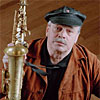Home » Jazz Articles » Multiple Reviews » Phil Woods: American Songbook II & Swingchronicity
Phil Woods: American Songbook II & Swingchronicity
 |  |
Phil Woods American Songbook II Kind of Blue 2007 | Phil Woods / DePaul University Jazz Ensemble Swingchronicity Jazzed Media 2007 |
More than other surviving members of the jazz generation that emerged during the primacy of bebop, alto saxophonist Phil Woods reflects the boppers' love of melody. That side of Bird, who enjoyed Gershwin, Porter and Kern as much as creating baroque façades on "I Got Rhythm" changes, echoes in Woods' approach to the standards known as the Great American Songbook. Woods honors the connection between bop and standards more than anyone else working today.
"You have to honor the lyrics—not memorize them, but know their intent," says Woods to American Songbook II notes writer Ted Panken. "You must know the harmony—not the bebop harmony or the Real Book harmony, but the traditional lead sheet harmony, which is completely different and beautiful." As that quote suggests, not only the harmonic structure but also the dramatic structure—the feeling or mood—of a song is important to how Woods and his quintet play it. Every one of the ten songs on the album is engaged with distinctive specificity, so that you're hearing the song as much as you're hearing the jazz improvisations on the song. And although this is a completely instrumental album, there's a definite vocal quality to Woods' alto sax tone and approach—just note how he 'sings' the melody of "Last Night When We Were Young." There's also a lot of bebop in the added ensemble shout choruses, underlining the bop/melody connection.
Woods and trumpeter Brian Lynch, who wrote the four charts Woods didn't, know how to craft and modulate the quintet's sound to each song, from the trumpet mutes used on "Careless," "Yesterdays" and "Watch What Happens" to the frequent use of brushes by drummer Bill Goodwin. And bassist Steve Gilmore often contributes melodic counterpoint as well as rhythm, while pianist Bill Charlap—a master of standards with his own trio—exults in exploring the contours of songs, whether taking the lead role on "I'll Take Romance" or offering a witty alternative to the burly horn solos on "Night and Day."
Back in the middle of the last century, Woods was a formidable soloist on big band and orchestral recordings (and even on a Billy Joel hit) and he still knows how to soar over a big band chart, as he shows on Swingchronicity. Woods is featured on the first seven of ten tracks, most notably on "Stockholm Sweetnin,'" reprising his role on the original Quincy Jones version, "It's You Or No One," where he trades rapid-fire fluency with the DePaul band director Bob Lark's flugelhorn, and Benny Golson's "Along Came Betty," new to Woods' discography. The DePaul University Jazz Ensemble is impressive throughout, definitely a Triple A if not fully Major League big band. It is equally good at providing the lush cushioning under Woods' solo on Quincy Jones' "Quintessence," fashioned by arranger Rob McConnell, as it is negotiating the shoals, still waters and rapids of Jim McNeely's "Rosenwind," including intricate interplay between Woods and the band. How good the band is becomes fully apparent on the last three tracks, where the absence of Woods is hardly an issue.
Tracks and Personnel
American Songbook II
Tracks: Foggy Day; All the Things You Are; I've Got You Under My Skin; When the Sun Comes Out; I Concentrate on You; Summertime; Let's Fall in Love; Every Time We Say Goodbye; World on a String; Right as the Rain.
Personnel: Phil Woods: alto saxophone & clarinet; Bill Charlap: piano; Steve Gilmore: bass; Bill Goodwin: drums; Brian Lynch: trumpet.
Swingchronicity
Tracks: I'm Getting Sentimental Over You; Stockholm Sweetnin'; Never Let Me Go; It's You or No One; Along Came Betty; The Quintessence; Rosenwind; Norweigian Summer; Skittish; Recessions.
Personnel: Phil Woods: alto sax; The DePaul University Jazz Ensemble : Bob Lark: director, flugelhorn (4); Dan Jonas: trumpet, flugelhorn; Gerald Bailey: trumpet, flugelhorn; Justin Surdyn: trumpet, flugelhorn; Jeff Kienstra: trumpet, flugelhorn; Nick Mazzarella: alto, soprano sax, flute; Lena Lien: alto, soprano, tenor sax, flute; Anthony Bruno: tenor sax, flute; Drew Pierson: tenor sax, clarinet; Rick Deja: baritone sax, bass clarinet; Bryant Scott: trombone; Ryan Kienstra: trombone; Andrew Zelm: trombone; Brian Honsberger: bass trombone; Ben Dockery: piano; Scott Hesse: guitar; Justin Thomas: vibraphone; Cory Biggerstaff: bass; Lawrence Haskin: drums.
< Previous
Standards
Next >
Vision Towards Essence
Comments
Tags
For the Love of Jazz
 All About Jazz has been a pillar of jazz since 1995, championing it as an art form and, more importantly, supporting the musicians who create it. Our enduring commitment has made "AAJ" one of the most culturally important websites of its kind, read by hundreds of thousands of fans, musicians and industry figures every month.
All About Jazz has been a pillar of jazz since 1995, championing it as an art form and, more importantly, supporting the musicians who create it. Our enduring commitment has made "AAJ" one of the most culturally important websites of its kind, read by hundreds of thousands of fans, musicians and industry figures every month.



















